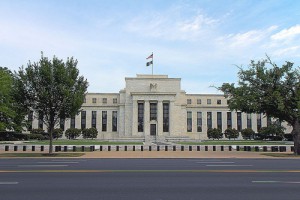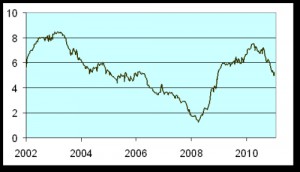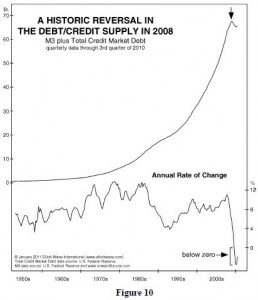The Federal Reserve System If you saw the HBO movie “Too Big to Fail,” you may have the notion that the Federal Reserve System, commonly known as The Fed, deals with high level banking issues that have worldwide implications. And you would be right. But The Fed also regulates banking functions that affect individual Americans, ranging from regulating debit card overdraft fees and limiting gift card fees to issuing U.S. Treasury savings bonds. History of the Federal Reserve The Founding Fathers were cautious about establishing a central bank, thinking that it would encourage irresponsible borrowing by the government. As a result, America functioned without a central bank throughout the … [Read more...]
What is the Fiscal Cliff and How is it Affecting the Economy
The fiscal cliff that is the current hot topic in the news is a combination of automatic spending cuts and tax hikes that are scheduled to go into effect at the end of 2012 and the beginning of 2013. The spending cuts were triggered when congress failed to reach a deficit reduction agreement during last years debt ceiling debate. The tax increases are also automatic because Congress failed to make the "Bush Tax Cuts" permanent opting instead for a more politically expedient temporary tax reduction. In other words, they "kicked the can down the road" and it landed at the end of 2012. Perhaps they were hoping the Mayans were right and the world would end before they had to deal with the … [Read more...]
The Long Road to Inflation Perdition
Today David Galland interviews Terry Coxon. Terry has worked hand in hand with the legendary best selling author Harry Browne together they wrote Inflation-Proofing Your Investments published in 1981 . Terry also wrote Keep What You Earn and is an expert in monetary systems and first started writing about inflation during the last major inflationary period of the 1970's. David Galland is editor of The Casey Report. How the Federal Reserve is Locking Up Inflation David Galland: You were involved with Harry Browne during the last great inflation in the U.S. How does the increase in the money supply that kicked off in 2007-2008 compare in terms of scale to what went on leading up to the … [Read more...]
Does The “FED” Really Just Print Money?
Printing Money, Quantitative Easing, Money Supply and Currency in Circulation--- how do they relate? Today we are looking at an excellent explanation on the FED's money printing process by James Hamilton, economist of the University of California, San Diego. Did the Federal Reserve really print a Trillion dollars in their Quantitative Easing program? Did that increase the money supply by a Trillion dollars? He presents some interesting charts on currency in circulation versus currency reserves. Tim McMahon, editor … [Read more...]
Why Quantitative Easing Has NOT Brought Back Inflation
When the FED began quantitative easing to halt the deflationary crash of 2008, almost everyone was convinced that it would result in massive inflation. The lone voice proclaiming that it wouldn't stop the deflationary express train wreck was Robert Prechter. In the following article Prechter explains why inflation never materialized. It is an excerpt from Prechter's, Independent Investor eBook 2011. I hope you enjoy this short excerpt. See below for details on how to get the eBook in its entirety for free. ~ Tim McMahon, editor … [Read more...]
Understanding the Federal Reserve Bank
What's a greater threat to the U.S. economy -- inflation or deflation? To decide that... it helps to understand what role the U.S. Federal Reserve plays. Despite so much focus on the policies of the Fed, its operations remain somewhat of a mystery to most investors -- in no smaller measure, due to their complexity. Here's an excerpt of a 35-page report that explains the Fed, its goals and, very importantly, its limitations in layman's terms. … [Read more...]
The Long Swim – How the Fed Could Become Insolvent
By Terry Coxon, Editor, The Casey ReportYou’ve seen the proof in real time. Once-dominant industrial companies, e.g., General Motors, can run out of money. The biggest banks, e.g., Bank of America, can run out of money. Even sovereign governments, e.g., Greece, can run out of money. Yes, all those organizations are still limping along, but only after being rescued by other giant institutions, such as the U.S. government, the less unhealthy European governments, the European Central Bank, and the International Monetary Fund. So far, it’s been easy to get rescued. The people who run giant institutions seem to shudder at the thought of other giant institutions being shown up as anything less … [Read more...]
What is the Federal Reserve – Part 3
Money, Credit and the Federal Reserve Banking System Conquer the Crash, Chapter 10 By Robert Prechter How the Federal Reserve Has Encouraged the Growth of Credit Congress authorized the Fed not only to create money for the government but also to “smooth out” the economy by manipulating credit (which also happens to be a re-election tool for incumbents). Politics being what they are, this manipulation has been almost exclusively in the direction of making credit easy to obtain. The Fed used to make more credit available to the banking system by monetizing federal debt, that is, by creating money. Under the structure of our “fractional reserve” system, banks were authorized to employ … [Read more...]
What is the Federal Reserve – Part 2
This is Part II of our three-part series "Robert Prechter Explains The Fed." In part 1 we saw how Central Banks came into being and money went from something tangible and of value like Gold or Silver to paper backed by Gold to paper backed by nothing. You can read Part I in "What is the Federal Reserve - Part 1" -- and come back later this week for Part III. "Let's attempt to define what gives the dollar objective value. As we will see in the next section, the dollar is 'backed' primarily by government bonds, which are promises to pay dollars. So today, the dollar is a promise backed by a promise..." … [Read more...]
What is the Federal Reserve – Part 1
Do you really know What a Dollar is? Or how the FED controls interest rates? What is quantitative easing? Or (QE2)? Or monetary stimulus? For answers, let's turn to someone who has spent a considerable amount of time studying the Fed and its functions: EWI president Robert Prechter. Today we begin a 3-part series that we believe will help you understand the Fed as well as he does. (Excerpted from Prechter's Conquer the Crash and the free Club EWI report, "Understanding the Federal Reserve System.") Here is Part I. … [Read more...]





